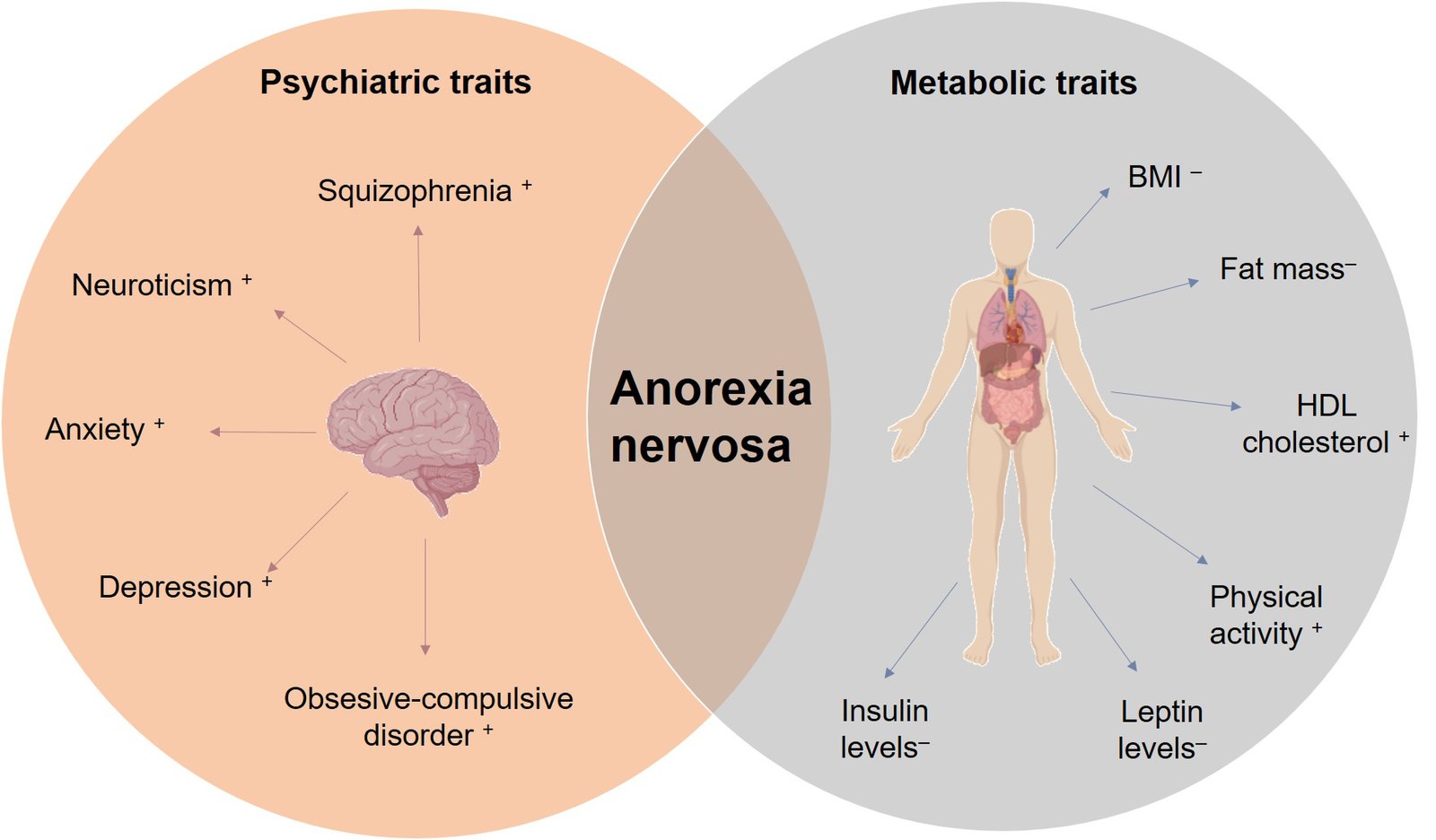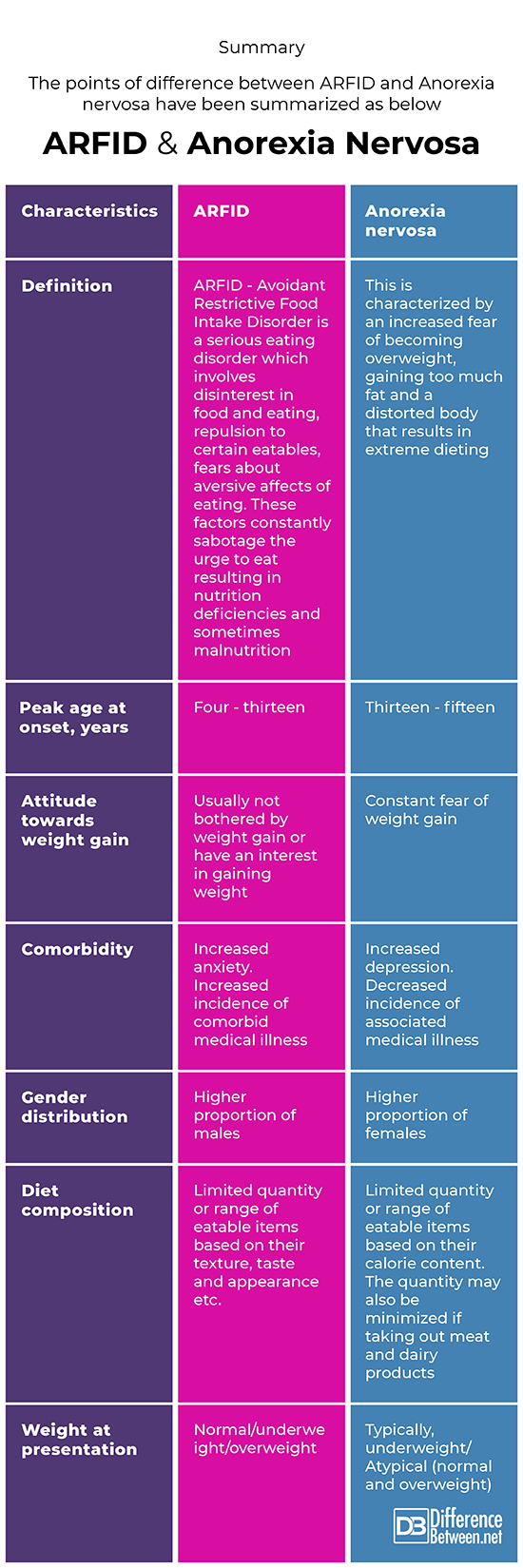Difference Between ARFID and Anorexia Nervosa
What is ARFID and Anorexia Nervosa?
ARFID and Anorexia nervosa are both eating disorders in which the common symptoms are nutritional deficiencies and weight loss. However, these two disorders are different as ARFID people have no interest in food or eating and ARFID people lack the urge for thinness. Anorexia nervosa people are extremely concerned for their weight. Other characteristics include negligence of food, curtailment of energy intake, extreme dieting due to fear on weight gain and elevated psychological anxiety associated with body shape and size.
Similarity
- Both disorders lead to nutritional deficiencies, Stomach and intestinal complications and malnutrition
- People with both of these disorders may often experience lack of concentration, dizziness and fainting
- Nutritional deficiency due to disinterest in eating and weight loss are common shared symptoms between the two disorders.

ARFID
It is defined as a food intake disorder that involves restriction of food intake by volume and/or variety resulting in extreme weight loss, damage to the psychosocial functioning, failure to thrive and nutritional deficiencies

Anorexia Nervosa
Anorexia nervosa is an eating disorder where an individual become extremely bothered and obsessed about his or her weight and what is being eaten. Symptoms include unwarranted fear of gaining weight, withdrawal from social activities, insecurity about the looks, low blood pressure and intolerance to cold. Unlike ARFID, this disorder is not actually about food, it is about intense fear of gaining weight and then body looking distorted due to it.
Difference between ARFID and Anorexia nervosa
Description
ARFID
It is an eating disorder which is characterized by picky and selective eating habits as well as disrupted food intake patterns
Anorexia nervosa
It is an eating disorder and psychological illness characterized by a significant curtailment in food and energy intake, intense fear of gaining fat and fear of distorted body appearance.
Symptoms
ARFID
- Significant weight loss
- Sudden refusal to eat foods
- Fatigue
- No body image struggles
- No fear of weight gain
- Fear of choking or vomiting
- No growth or delayed growth
- Nutrient deficiencies (vitamin A, B, C, D, iron, calcium is the common)
- Abdominal pain
- Cold intolerance
- Malnutrition
- Becomes emotional or demonstrates anxiety and displeasure around unfamiliar foods
- Only eating food with particular structures
- Excess energy
- Co-occurring anxiety disorders
Anorexia nervosa
- Fast weight loss
- Dizziness
- Starvation
- Fainting
- Yellow skin
- Irregular heart beat
- Abnormal blood count
- Small meals
- Abnormal pain and constipation
- No menstruation
- Artificially induced vomiting after eating
- Sleep disorders
- Constant feeling of cold
- Fear of excess weight
- Amenorrhea
- Halitosis
- Bluish fingers and brittle nails
- Swollen arms and legs
- Dry skin and hair loss
- Increased liver enzymes
- Loss of bone calcium (osteoporosis)
- Decreased libido in adults
- Teeth erosion form purging
- Dehydration
Causes
ARFID
- An individual predisposed to ARFID due to his genes may get this condition triggered by certain external factors like the environmental, sociocultural and psychosocial situations, like some traumatic episode.
- Disrupted and erratic eating patterns exist in other mental disorders, dual diagnosis or comorbidity – such as depression disorders, cognitive disabilities, and autism may exacerbate the issue of ARFID
- Sensory aversion
Anorexia nervosa
- Heredity
- Depression
- Gastrointestinal tract diseases
- Mental disorder
- Drug addiction
- Alcoholism
Summary
The points of difference between ARFID and Anorexia nervosa have been summarized as below:

FAQ
Can you have both ARFID and Anorexia nervosa?
No. The reason is that in ARFID the person is not bothered about being thinness which is the opposite in case for individuals with Anorexia nervosa.
How do I know if I have ARFID?
A person with Avoidant Restrictive Food Intake Disorder displays several physical and behavioral warning signs like sudden denial to eat, a constant fear of puking after eating. Some physical signs include; delayed or no development and growth, significant weight loss and abdominal pain and cold intolerance
What exactly is ARFID?
ARFID is Avoidant Restrictive Food Intake Disorder in which there is disinterest in food and eating and the disorder is primarily characterized by a constant neglect to meet suitable and required nutritional or energy needs.
How is ARFID different from picky eating?
ARFID people have absolutely no interest in food and eating and will say that they are not hungry. Basically, food is not a priority for ARFID people. In contrast, picky eaters refuse certain types of foods and often eat the foods they enjoy again and again. Picky eaters do feel hungry and do not show lack of interest in food and eating as the ARFID people.
- Difference Between Global Warming and Greenhouse Effect - May 18, 2024
- Difference Between Vaccination and Immunization - March 3, 2024
- Difference Between Selective Mutism and Autism - February 25, 2024
Search DifferenceBetween.net :
1 Comment
Leave a Response
References :
[0]Fombonne, E. (1995). Anorexia nervosa. The British Journal of Psychiatry, 166(4), 462-471.
[1]Hay, P., Mitchison, D., Collado, A. E. L., González-Chica, D. A., Stocks, N., & Touyz, S. (2017). Burden and health-related quality of life of eating disorders, including Avoidant/Restrictive Food Intake Disorder (ARFID), in the Australian population. Journal of eating disorders, 5(1), 1-10.
[2]Steinhausen, H. C. (2002). The outcome of anorexia nervosa in the 20th century. American journal of Psychiatry, 159(8), 1284-1293.
[3]Zimmerman, J., & Fisher, M. (2017). Avoidant/restrictive food intake disorder (ARFID). Current problems in pediatric and adolescent health care, 47(4), 95-103.
[4]Image credit: https://commons.wikimedia.org/wiki/File:Association_of_Anorexia_nervosa_with_psychiatric_and_metabolic_traits.jpg
[5]Image credit: https://www.ifemdr.fr/wp-content/uploads/2021/01/dossier-emdr-et-tca.jpg

I’m terrified to eat as I get sick a lot when I do and in the past I got very very sick when ate so developed a fear of food making me sick so I eat the same food all the time. I’m very color and texture oriented too.
I have been diagnosed with arfid. I also don’t want to have any fat so as i try to gain weight I want it to be muscle. I have a fear of fat but also a fear of being too thin and fragile. at the same time I’m extremely health food conscious and only eat whole foods that are super healthy. I feel I could have arfid, orthorexia and anorexia. is this possible? I’m scared I’m 115lbs and
5 10″ always cold, hungry, weak, low heart rate and low blood pressure.
I know I have arfid and orthorexia but part of me likes being small I don’t understand! I feel like 2 different people live inside me.